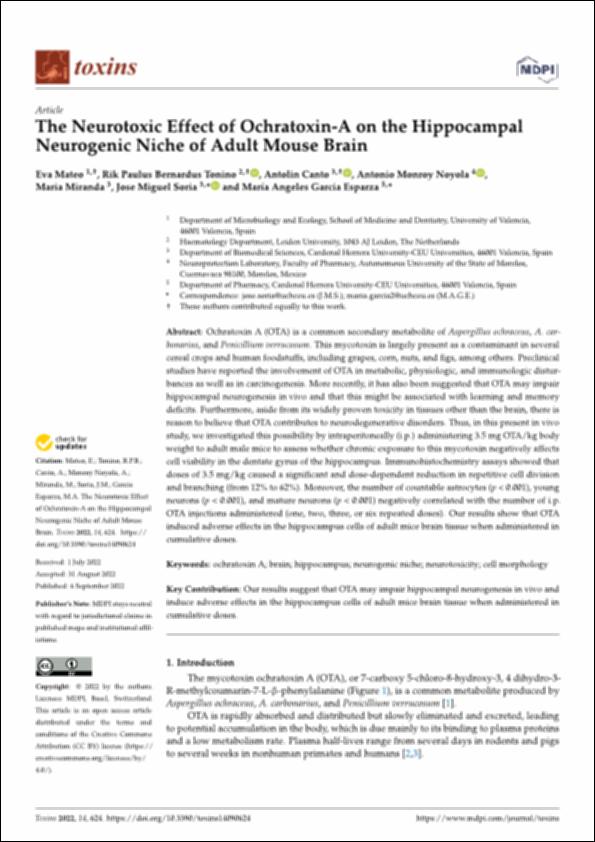Please use this identifier to cite or link to this item:
http://hdl.handle.net/10637/14029The neurotoxic effect of Ochratoxin-A on the hippocampal neurogenic niche of adult mouse brain
| Title: | The neurotoxic effect of Ochratoxin-A on the hippocampal neurogenic niche of adult mouse brain |
| Authors : | Mateo Jiménez, Eva María Tonino, Rik Paulus Bernardus Cantó Catalá, Antolín Monroy Noyola, Antonio Miranda Sanz, María Soria López, José Miguel García Esparza, María Ángeles |
| Keywords: | Células - Morfología.; Cells - Morphology.; Hipocampo (Cerebro) - Efectos de los productos químicos.; Ocratoxina A - Efectos fisiológicos.; Hippocampus (Brain) - Effects of chemicals on.; Micotoxinas - Efectos fisiológicos.; Mycotoxins - Physiological effect.; Neurotoxicología.; Neurotoxicology.; Ochratoxin A - Physiological effect. |
| Publisher: | MDPI |
| Citation: | Mateo, E., Tonino, R. P. B., Canto, A., Monroy Noyola, A., Miranda, M., Soria, J. M., & Garcia Esparza, M. A. (2022). The neurotoxic effect of Ochratoxin-A on the hippocampal neurogenic niche of adult mouse brain. Toxins, vol. 14, i. 9, art. 624 (06 sep.). DOI: http://dx.doi.org/10.3390/toxins14090624 |
| Abstract: | Ochratoxin A (OTA) is a common secondary metabolite of Aspergillus ochraceus, A. carbonarius, and Penicillium verrucosum. This mycotoxin is largely present as a contaminant in several cereal crops and human foodstuffs, including grapes, corn, nuts, and figs, among others. Preclinical studies have reported the involvement of OTA in metabolic, physiologic, and immunologic disturbances as well as in carcinogenesis. More recently, it has also been suggested that OTA may impair hippocampal neurogenesis in vivo and that this might be associated with learning and memory deficits. Furthermore, aside from its widely proven toxicity in tissues other than the brain, there is reason to believe that OTA contributes to neurodegenerative disorders. Thus, in this present in vivo study, we investigated this possibility by intraperitoneally (i.p.) administering 3.5 mg OTA/kg body weight to adult male mice to assess whether chronic exposure to this mycotoxin negatively affects cell viability in the dentate gyrus of the hippocampus. Immunohistochemistry assays showed that doses of 3.5 mg/kg caused a significant and dose-dependent reduction in repetitive cell division and branching (from 12% to 62%). Moreover, the number of countable astrocytes (p < 0.001), young neurons (p < 0.001), and mature neurons (p < 0.001) negatively correlated with the number of i.p. OTA injections administered (one, two, three, or six repeated doses). Our results show that OTA induced adverse effects in the hippocampus cells of adult mice brain tissue when administered in cumulative doses. |
| Description: | Este artículo se encuentra disponible en la página web de la revista en la siguiente URL: https://www.mdpi.com/2072-6651/14/9/624 Este artículo de investigación pertenece al número especial titulado "Evaluation and Prevention of Mycotoxin Contamination and Toxicological Effects". |
| URI: | http://hdl.handle.net/10637/14029 |
| Rights : | http://creativecommons.org/licenses/by/4.0/deed.es |
| ISSN: | 2072-6651 (Electrónico) |
| Issue Date: | 6-Sep-2022 |
| Center : | Universidad Cardenal Herrera-CEU |
| Appears in Collections: | Dpto. Ciencias Biomédicas |
Items in DSpace are protected by copyright, with all rights reserved, unless otherwise indicated.


